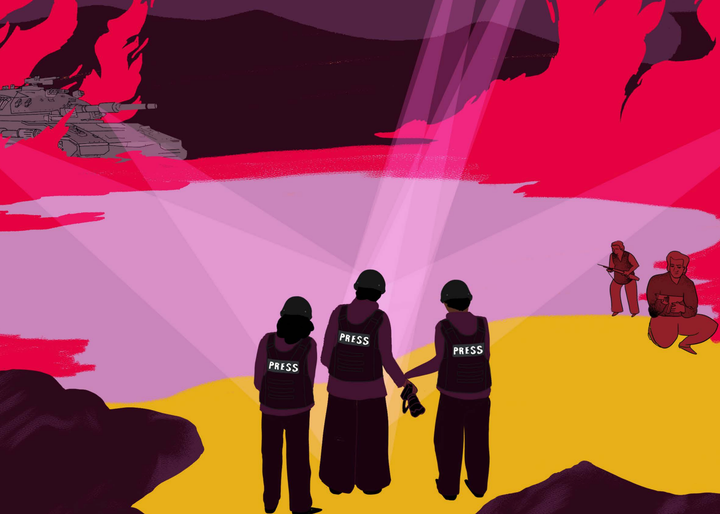The Reporting That Led Israel To Arrest, Detain, and Prosecute An American Journalist
Loffredo openly defied a Israeli military censor, which thousands of other international journalists have allowed to influence what they publish on Israel's war on Gaza
The following is a transcript of Grayzone contributor Jeremy Loffredo's reporting from Israel. He was arrested, detained, and charged with "aiding the enemy" and "providing information to the enemy." More here.
I’m Jeremy Loffredo for the Grayzone in Israel, where last night Iran fired over 200 ballistic missiles in retaliation for the assassinations of Lebanese and Iranian political and military leadership. Since the missile strikes, Israeli authorities have attempted to downplay the significance of the attacks, censor the locations of missile impacts from media publications, and claim that Iran was targeting Israeli civilians.
What I saw today here in Israel is clear evidence that Iran was targeting the same Israeli intelligence and military installations that’s been used over the past year to carry out brutal assassinations and attacks.
The morning after the missile strikes news reports indicated that one of the principal targets was Nevatim airbase. Nevatim airbase, located deep in the Negev Desert, is the largest most critical air force base in Israel.
It’s home to three squadrons of US-supplied Lockheed Martin stealth fighter jets, which have played a pivotal role in Israel’s year-long air assault on the besieged Gaza Strip, and as of two weeks ago, these F-35s are also spearheading relentless and devastating strikes in southern Lebanon—so far resulting in the deaths of 2,000 civilians.
The base is also home to Wings of Zion, the Israeli equivalent of Air Force One. Video footage taken around by Israelis and Israeli Bedouin who live around the Negev Desert, show Nevatim airbase being hit by at least 10 ballistic missiles. [video shown]
I drove 70 miles south to the highly sensitive air force installation, aiming to document the underreported and potentially embarrassing destruction. As I approached the military base, F-35 fighter jets were vertically landing at the base in all likelihood on their way back from killing 30 miles away in Gaza or 100 miles away in Lebanon. The road was separated from the base by more than a mile of desert and miles of steel fencing so seeing any destruction was impossible.
In the Negev Desert, there are 46 Palestinian Bedouin villages. Eighty-seven percent of these villages are “unrecognized” by Israel and face constant demolition orders on any permanent or semi-permanent structure, resulting in most of their homes and buildings being built with light material like plywood or sheet metal.
I went village to village asking about the missile strikes. Most Bedouins were suspicious of me, but two young men, who told me the explosions scared their wives and children, claimed they knew where a missile had fallen. They led me there, but they were unwilling to appear on camera due to concerns for their safety.
The military took away most of the missile, but there was still a piece left. The missile fell a quarter mile west of Nevatim airbase and about a quarter mile from the Bedouin village, which is unrecognized by Israel so it isn’t supplied with any state-of-the-art bomb shelters like Jewish communities.
LOFFREDO: Where were people in the communities hiding yesterday during the sounds?
VILLAGER: [translation] Some of our people ran to the school. Lots of us went to the bridge underpass. We aren’t safe because our people have not been given any shelters or safe places to hide.
PALESTINIAN CAB DRIVER: [camera pointed at bridge underpass] Many people sheltered here last night. With the sounds of the rockets we came to hide here.
As night fell, I headed to the heart of Israel’s intelligence and military operations: Tel Aviv.
This city is home to the nucleus of the state’s defense apparatus, and by Israel’s own logic, the civilians here could be considered human shields. At the center of this high density urban area lies the headquarters of Mossad, Israel’s intelligence agency where covert operations, assassinations, espionage, and blackmail plots are devised against state enemies.
It’s not just that schools or hospitals are nearby. Mossad’s headquarters is strategically nestled among them with apartment complexes, tourist hubs, and public facilities all around. Rumors had been circulating online with unverified videos suggesting that the Iranian missile barrage targeted this very headquarters. However finding the exact impact site was difficult. Israel’s military censor had barred from reporting the locations of the missile strike.
Using visual clues from footage circulating online, I set out to locate where the missile may have landed. Driving down a street I believed to be in one of the missile videos, I saw a heavily damaged SUV, its windshield shattered, debris and concrete caked into the vehicle. Further down, the scene unfolded—destroyed vehicles, torn up asphalt, and a massive crater roughly 30 feet wide recently filled in with dirt.
CAB DRIVER: That’s the Mossad headquarters.
The missile had hit less than 1000 feet from Mossad headquarters. This information is missing from all Israeli reports due to the fact it’s been officially censored. Right here are the censored coordinates. Given the proximity to what is considered one of the world’s most advantaged intelligence, it seemed clear that Israel was taking extra precautions to conceal the exact impact location.
As we left the area, an unsettling incident occurred. Our cellphones lost GPS functionality. Maps went blank, and then both devices, mine and my taxi driver’s, suddenly showed me were at Amman’s airport in Jordan over 120 miles west. For the Grayzone, in Israel, Jeremy Loffredo.




Comments ()